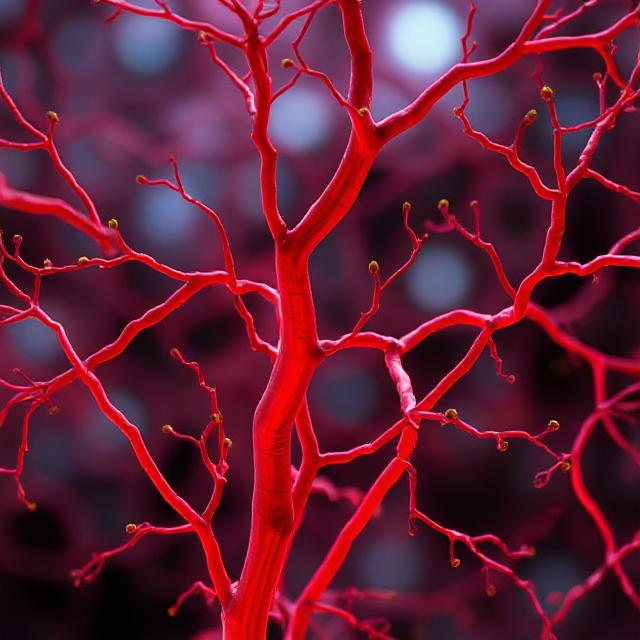Bioengineered scaffolds are at the forefront of regenerative medicine, offering the promise of growing functional tissues—from blood vessels to teeth—in controlled laboratory environments. These innovative techniques blend tissue engineering, material science, and cellular biology to overcome limitations of conventional implants and surgical grafts. In this post, we explore groundbreaking research on lab-grown blood vessels and bioengineered teeth, examine the underlying technology of synthetic gene circuits that enhance cell therapies, and discuss future directions for this dynamic field.
Lab-Grown Blood Vessels: Engineering Life’s Highways

Imagine a blood vessel grown entirely in the lab, engineered from real human cells without the risk of immune rejection. This is not science fiction but a rapidly advancing reality. One company is currently producing these lab-grown vessels in batches of 200 using custom-designed, degradable polymer scaffolds. Here’s how the process works:
- Scaffold Design & Dimensions:
- The scaffolds measure 42 centimeters in length and 6 millimeters in thickness.
- They are made from a degradable polymer, designed to provide temporary structural support as the tissue grows.
- Cell Seeding and Incubation:
- Each scaffold is placed in an individual bag and seeded with millions of donor cells.
- The bags are then loaded into a school-bus-sized incubator, where they soak in a nutrient-rich bath for approximately two months.
- During this period, the cells secrete collagen and other proteins that gradually build the structural framework of the vessel.
- De-Cellularization:
- Once the tissue is mature, the polymer scaffold is allowed to dissolve.
- A special washing solution is used to remove the remaining cellular material, leaving behind a flexible, decellularized tissue.
- Because the final product lacks living cells, it minimizes the risk of rejection when implanted into a patient.
This method holds immense promise for vascular grafting and other cardiovascular applications. The ability to generate a patient-friendly vessel, precisely engineered to match natural tissue properties, could transform treatments for conditions like coronary artery disease and peripheral vascular disease.
Bioengineered Teeth: A New Era for Dental Implants

Traditional dental implants, typically made from titanium, come with several challenges. Despite their widespread use, these implants can suffer from issues such as jawbone resorption and peri-implantitis, leading to a limited predicted survival of around 15 years. Researchers have been actively pursuing biological tooth substitutes that mimic the structure and function of natural teeth.
The Challenge of Dental Replacements
- Current Limitations:
- Longevity Issues: Traditional implants may not integrate well over time, leading to bone loss and eventual failure.
- Infection Risk: Peri-implantitis, an inflammatory process, poses a significant threat to the long-term viability of synthetic implants.
The Bioengineered Approach
Pioneering studies at Tufts University by Weibo Zhang and Pamela Yelick are focusing on creating functional, biological tooth substitutes. Their research involves:
- Using Real Dental Cells:
- Cells are taken from actual teeth and used to grow tooth-like structures in the lab.
- Engineering Living Tissue Implants:
- These bioengineered teeth are composed entirely of living tissues, offering properties similar to natural teeth.
- This approach aims to overcome the drawbacks of synthetic titanium implants and provides a more natural and durable solution.
- Mini-Pig Studies:
- In preclinical models, such as mini pigs, researchers have successfully grown human-like teeth, demonstrating promising functionality and integration.
- In preclinical models, such as mini pigs, researchers have successfully grown human-like teeth, demonstrating promising functionality and integration.
Potential Benefits
The development of bioengineered teeth could revolutionize dental care by:
- Enhancing Longevity:
- Living tissue implants are expected to integrate more naturally with the patient’s jawbone, reducing the risk of resorption.
- Improving Functionality:
- By closely mimicking natural tooth composition, these implants could offer better performance in terms of durability and responsiveness.
- Reducing Infection Risks:
- Living tissue has the inherent ability to adapt and resist bacterial invasion, potentially lowering the incidence of peri-implantitis.
Synthetic Gene Circuits: Enhancing Engineered Cell Therapies
While bioengineered scaffolds provide the physical framework for tissue regeneration, another exciting frontier in biomedical engineering involves the use of synthetic gene circuits. These circuits are designed to endow cells with therapeutic functions by conditionally regulating protein expression and activity. According to a recent review in Nature Reviews Bioengineering, these synthetic macromolecular systems integrate transcriptional, translational, and post-translational mechanisms to respond dynamically to internal and external stimuli.
How Synthetic Gene Circuits Work
Synthetic gene circuits are akin to programming cells to perform specific tasks. They can:
- Control Protein Expression:
- Switch on or off certain genes based on environmental signals, ensuring that therapeutic proteins are produced only when needed.
- Enhance Safety and Efficacy:
- By finely tuning protein production, these circuits can reduce side effects and improve the overall efficacy of engineered cell therapies.
- Facilitate Complex Cellular Behaviors:
- Enable cells to mimic natural physiological responses, which is crucial for integration with host tissues.
Integration with Bioengineered Scaffolds
When integrated with bioengineered scaffolds, synthetic gene circuits can offer an added layer of control. For example:
- Adaptive Tissue Regeneration:
- In a lab-grown blood vessel, gene circuits could be programmed to respond to stress signals, triggering the production of additional collagen if structural support is compromised.
- Targeted Therapeutic Action:
- In the case of bioengineered teeth, gene circuits might regulate the differentiation of cells to ensure that the tissue develops the appropriate hardness and resilience.
Benefits in Clinical Applications
- Improved Therapeutic Outcomes:
- By combining physical scaffolds with dynamic gene regulation, therapies can be more responsive to patient-specific needs.
- Minimized Risk of Overgrowth or Malformation:
- Gene circuits help maintain tissue homeostasis, reducing the chance of unwanted tissue proliferation.
- Enhanced Integration:
- Tissues grown in this manner are more likely to integrate seamlessly with the patient’s body, leading to improved long-term outcomes.
Key Advantages of Bioengineered Scaffolds
The integration of bioengineered scaffolds into regenerative medicine offers several significant advantages:
- Personalization:
- Tissues can be customized to match the patient’s unique biological makeup, reducing the risk of immune rejection.
- Scalability:
- The production processes, such as the batch manufacturing of blood vessels, can be scaled to meet clinical demand.
- Reduced Reliance on Synthetic Implants:
- By replacing inert materials with living tissues, patients may experience improved functionality and longevity.
- Dynamic Adaptability:
- The use of synthetic gene circuits allows for real-time adjustments during tissue development, ensuring optimal performance.
- Minimized Surgical Risks:
- Decellularized tissues reduce the likelihood of rejection and infection, streamlining the path to clinical use.
The Process in Detail: From Lab to Clinic
Let’s take a closer look at the journey of a bioengineered blood vessel—from the initial scaffold design to the final decellularized tissue ready for implantation:
- Scaffold Fabrication:
- Custom-designed degradable polymer scaffolds are fabricated with precise dimensions (42 cm x 6 mm) to mimic the architecture of natural blood vessels.
- Cell Seeding:
- Each scaffold is individually bagged and seeded with millions of donor cells. This high-density seeding ensures that the entire scaffold is uniformly colonized.
- Incubation:
- The seeded scaffolds are placed in a large incubator, where they are immersed in a nutrient-rich bath for about two months.
- During incubation, the cells secrete collagen and other extracellular matrix proteins, gradually forming a natural tissue structure.
- Scaffold Dissolution and Washing:
- After sufficient tissue growth, the degradable polymer scaffold is allowed to dissolve.
- A specialized solution is used to wash away any residual cellular debris, resulting in a decellularized tissue that retains the original structure.
- Final Product:
- The resulting tissue is flexible and robust, perfectly shaped to function as a blood vessel.
- Because it is decellularized, the tissue is less likely to trigger immune responses when implanted.
A similar, meticulously controlled process is being applied to bioengineered teeth, where the focus is on replicating the complex structure and functionality of natural dental tissues.
Future Directions and Clinical Impact
The advancements in bioengineered scaffolds and synthetic gene circuits represent just the beginning of a new era in regenerative medicine. Researchers and clinicians are exploring various avenues to expand these technologies:
Emerging Trends
- Personalized Medicine:
- Tailoring tissue engineering approaches to individual genetic profiles could further minimize rejection and improve integration.
- Integration of AI and Robotics:
- Automated systems may soon optimize scaffold fabrication and cell seeding processes, increasing precision and efficiency.
- Advanced Biomaterials:
- New degradable polymers and nanomaterials are being developed to further enhance scaffold performance.
- Multi-Tissue Engineering:
- Combining different types of tissues (e.g., blood vessels with nerve fibers) could lead to the creation of more complex, functional organs.
Clinical Applications on the Horizon
- Cardiovascular Surgery:
- Lab-grown blood vessels could be used in bypass surgeries, vascular grafts, and other procedures, reducing complications and improving recovery.
- Dental Restoration:
- Bioengineered teeth hold the potential to replace failing dental implants, offering improved longevity and functionality.
- Tissue Regeneration:
- Beyond blood vessels and teeth, bioengineered scaffolds may be used to reconstruct skin, cartilage, and even entire organs in the future.
- Targeted Cell Therapies:
- By integrating synthetic gene circuits, engineered tissues can be programmed to respond to disease-specific signals, paving the way for highly targeted treatments.
Challenges to Overcome
Despite the promise, several hurdles remain before these technologies become routine in clinical practice:

- Regulatory Approval:
- Stringent safety and efficacy standards must be met, which requires extensive preclinical and clinical testing.
- Manufacturing Scalability:
- While current processes are scalable, further advancements are needed to produce tissues in larger quantities at a lower cost.
- Long-Term Stability:
- Ensuring that bioengineered tissues maintain their functionality over extended periods is crucial for their success in patients.
- Integration with Host Tissues:
- Fine-tuning the interaction between engineered tissues and the patient’s natural cells remains an active area of research.
Conclusion
The field of bioengineered scaffolds is rapidly evolving, offering transformative potential in regenerative medicine. From lab-grown blood vessels that can seamlessly integrate into the human body to bioengineered teeth that promise to outlast synthetic implants, these innovations signal a paradigm shift in how we approach tissue repair and replacement.
Key takeaways include:
- Advanced Scaffold Fabrication:
- Custom-designed degradable polymers are revolutionizing tissue engineering.
- Cell Seeding and Incubation Techniques:
- Controlled environments allow for the precise growth of functional tissues.
- Integration with Synthetic Gene Circuits:
- Dynamic regulation of protein expression enhances the safety and efficacy of engineered cell therapies.
- Clinical Potential:
- Applications range from cardiovascular surgeries to dental restorations and beyond, with personalized and adaptive approaches on the horizon.
As researchers continue to push the boundaries of science, the integration of bioengineered scaffolds with sophisticated genetic programming will likely redefine the future of medicine. By overcoming current challenges through innovative design and interdisciplinary collaboration, we move closer to a world where lab-grown tissues not only restore function but also improve the quality of life for patients worldwide.
The journey from the lab bench to clinical application is complex, but the progress thus far provides a solid foundation for the next generation of regenerative therapies. As new materials, automation, and personalized approaches come into play, the possibilities for tissue engineering are virtually limitless.
References:
- Lab-grown blood vessel production process and benefits –
- Bioengineered teeth in mini pigs and challenges of dental implants –
- Advances in synthetic gene circuits for engineered cell therapies –
By harnessing the power of bioengineered scaffolds, researchers and clinicians are taking bold steps toward a future where the body’s natural repair mechanisms can be seamlessly enhanced and replicated. The convergence of advanced biomaterials, precise cell culturing techniques, and synthetic gene circuits is not only revolutionizing tissue engineering but also setting the stage for a new era of personalized regenerative medicine.
